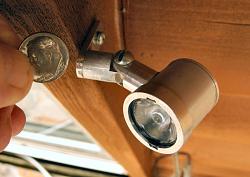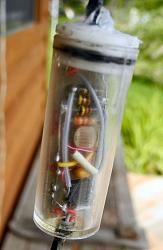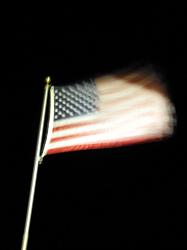The American flag should be either lowered or illuminated at night.
Solar powered flag lights are readily available. I found one for $29.95 at Menard's. Unfortunately, they are quite feeble, seemingly providing about as much light as a birthday candle or an excited firefly. So I decided to make a light. Mine does not need to be solar powered. My flag pole is only about 20 feet from the cabin, so my flag light can be mounted on the cabin and powered from an outside outlet.
I used a CREE XP-G2 white LED . This LED produces about 254 lumens when fed with 700 mA of current. These are $3.99 each. I coupled it to a Carlco 10003 molded plastic TIR (total internal reflection) optic with a 12-degree beamwidth. These are $1.25 each. The lens is held in a Carlco 10734 20mm plastic lens holder for 23 cents. All of the foregoing are available from a number of sources. I used
LEDSupply - For All Your LED Project Needs!.
I machined the housing from 1" dia aluminum barstock. There is a cylindrical aluminum slug inside. The star-mounted LED mates up against the end of this slug with thermal grease. The slug fits snugly inside the housing with about .001" radial clearance, with thermal grease filling the gap. This provides intimate thermal contact between the LED and the housing so the entire housing can serve as a heat sink. The result is that when running a bit more than 2.25 watts (750 mA at about 3 volts) the case temperature is less than 120 deg F, a very comfortable temp for the LED. A rear cap is press-fit into the housing to seal it.
The lens fits snugly in the housing and is seated on the LED. It is held in place by the lens holder, which has little posts that seat into holes in the LED's star mount. All this is fixed in place axially by a nose collar that was machined to be a waterproof (.001" interference) press fit on the housing. There is a thin film of silicone between the collar and the lens and lens holder.
The leads come out thru a hole in the back cap which has been plugged and sealed with Silicone RTV, aka "elephant snot".
Simple electronics comprised of a cadmium sulfide cell, (surplus store or Digi-Key)), a cheap opamp (ST TS951LT, $0.89 from Digi-Key), a P-channel MOSFET and a few resistors comprise a series switch that turns the light on at late dusk when it is nearly dark and turns it off at early dawn. This lot is housed in a transparent pill bottle. The wire coming out the bottom is plugged with elephant snot. A plug was machined from delryn to fit the other end, with an O-ring seal. The hole in it that passes wire is also plugged and sealed with elephant snot.
I made an electronic current regulator for my light because I had all of the parts on hand, but a suitable power supply could also be just a 5-volt wallwart USB supply in series with a 2.7 ohm 2-watt resistor.
The light illuminates the flag very satisfactorily as can be seen in this photo.
This is not photoshopped; it's really what it looks like. It was very windy the night I took the photo so the flag is blurred, but you don't need a needle-sharp image to get a general impression of how it looks at night.
It is probably visible from across the lake 1.5 miles distant. Because the very tight 12-degree beam of light is aimed upwards at the flag atop an 17-foot pole, my neighbors can go skinny-dipping at night confident that they are quite invisible in stygian darkness though less than 100 feet from my flagpole.


 LinkBack URL
LinkBack URL About LinkBacks
About LinkBacks





 Reply With Quote
Reply With Quote



Bookmarks